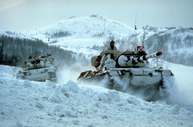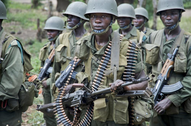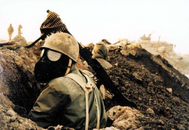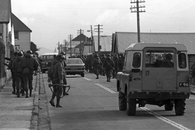Third Great War: Difference between revisions
No edit summary |
No edit summary |
||
| Line 66: | Line 66: | ||
The '''Third Great War''', often abbreviated as '''GWIII''' or '''GW3''', was a [[Great Wars|global war]] that lasted from 1976 to 1983, involving countries from all continents except [[Lohicamia]]. The Third Great War involved all of the world's {{wp|major powers}}, united into two opposing alliances: the [[Third Coalition]] (led by the [[The Furbish Islands|Furbish Islands]], [[Fluvannia]], [[Greater Niagara]], and [[Confederate Alaoyi|Alaoyi]]) and the [[Communist Ascendancy]] (led by [[Gagium]], [[Zurokist Alanna|Alanna]], [[Pätschlàn]], [[Komrep Inglaterra|Inglaterra]], and [[Seocheon]]). The participants threw the whole of their economies, industries, and sciences into a total war that blurred the line between civilian and military targets. Strategic bombing, indiscriminate artillery bombardment, and chemical weapons inflicted millions of civilian casualities. | The '''Third Great War''', often abbreviated as '''GWIII''' or '''GW3''', was a [[Great Wars|global war]] that lasted from 1976 to 1983, involving countries from all continents except [[Lohicamia]]. The Third Great War involved all of the world's {{wp|major powers}}, united into two opposing alliances: the [[Third Coalition]] (led by the [[The Furbish Islands|Furbish Islands]], [[Fluvannia]], [[Greater Niagara]], and [[Confederate Alaoyi|Alaoyi]]) and the [[Communist Ascendancy]] (led by [[Gagium]], [[Zurokist Alanna|Alanna]], [[Pätschlàn]], [[Komrep Inglaterra|Inglaterra]], and [[Seocheon]]). The participants threw the whole of their economies, industries, and sciences into a total war that blurred the line between civilian and military targets. Strategic bombing, indiscriminate artillery bombardment, and chemical weapons inflicted millions of civilian casualities. | ||
The Third Great War was the deadliest conflict in human history; it resulted in over | The Third Great War was the deadliest conflict in human history; it resulted in over TBD million fatalities between military and civilian deaths. Tens of millions were killed due to starvation, genocide, and disease. As a result, tribunals of war criminals were conducted against Gagian, Inglaterran, and Alannan leaders. Gagium, along with parts of Inglaterra and Alanna, were occupied by Coalition forces. | ||
The causes of the Third Great War are debated, but most historians agree that the unresolved conflict in the León Monarchy, tensions between Alaoyi and Inglaerra, the ineffectiveness of the [[Forum and Council of Nations]], and the rise of hardline communist governments in many countries contributed to causing the war. The Third Great War is generally considered to have started when Inglaterra and Alanna invaded Alaoyi and | The causes of the Third Great War are debated, but most historians agree that the unresolved conflict in the León Monarchy, tensions between Alaoyi and Inglaerra, the ineffectiveness of the [[Forum and Council of Nations]], and the rise of hardline communist governments in many countries contributed to causing the war. The Third Great War is generally considered to have started when Inglaterra and Alanna invaded Alaoyi and Niagaran [[Antarctic Circle States|Antarctica]] and [[Niagaran Canal Colony|the Niagaran-owned Trans-Frigo canal.]] on 12 March 1976. The invasion of Alaoyi opened one of the largest land theaters of war in history. From early 1976 to mid 1977, Inglaterran and Alannan troops advanced deep into Alaoyian territory. However, the winter of 1976 provided Alaoyian troops with time to build up their defenses in the Diash mountains. Following a series of failed attacks by Ascendancy troops, including the [[Battle of Merileach]] (one of the bloodiest battles in history), turned the tide of the conflict. With Naossia joining the war and the arrival of [[Royal Commonwealth of Nations|Commonwealth]] reinforcements, Coalition forces in Galia managed to begin pushing the Ascendancy back. By the start of 1979, Coalition troops had begun advancing into Inglaterran territory and the capture of key ports in southern Alanna meant that Alannan troops could not resupply Ascendancy forces as easily. The Galian front turned towards solely Alanna when Inglaterra capitulated in 1981. | ||
While the invasion of the Niagaran Canal Colony brought Fluvannia, Niagara, and the Furbish Islands into the war, Gagium, Pätschlàn, and Seocheon declared war on the Third Coalition. Conflict between these powers had already been going on as the two sides funded proxy wars and small interventions in the León Monarchy, with the Third Coalition supporting the [[House of Khakmadoy]] and the Communists supporting the [[House of Santa Bárbara]]. In April 1976, Gagian aircraft attacked Furbish and Niagaran military bases in Stratea and the Tenific Ocean. Fighers and bombers launching from the [[Perlsienne Islands|Perlsienne]] struck the Furbish Islands themselves. The Coalition nations of Galia declared war on the Stratean powers in solidarity, though they would have little effect on the outcome of the war in Stratea. Ascendancy forces would capture key islands and push deep into Khakmadoyan territory. However, the advantage turned towards the Coalition when a joint Furbish-Niagaran invasion captured the Perlsienne Islands, restricting the ability of Ascendancy forces to attack the Furbish Islands directly. Further naval defeats cost the Ascendancy powers their initiative and forced them into strategic retreat on all fronts by 1979. In 1981, Coalition forces landed in Alanna and Gagium for the first time. | While the invasion of the Niagaran Canal Colony brought Fluvannia, Niagara, and the Furbish Islands into the war, Gagium, Pätschlàn, and Seocheon declared war on the Third Coalition. Conflict between these powers had already been going on as the two sides funded proxy wars and small interventions in the León Monarchy, with the Third Coalition supporting the [[House of Khakmadoy]] and the Communists supporting the [[House of Santa Bárbara]]. In April 1976, Gagian aircraft attacked Furbish and Niagaran military bases in Stratea and the Tenific Ocean. Fighers and bombers launching from the [[Perlsienne Islands|Perlsienne]] struck the Furbish Islands themselves. The Coalition nations of Galia declared war on the Stratean powers in solidarity, though they would have little effect on the outcome of the war in Stratea. Ascendancy forces would capture key islands and push deep into Khakmadoyan territory. However, the advantage turned towards the Coalition when a joint Furbish-Niagaran invasion captured the Perlsienne Islands, restricting the ability of Ascendancy forces to attack the Furbish Islands directly. Further naval defeats cost the Ascendancy powers their initiative and forced them into strategic retreat on all fronts by 1979. In 1981, Coalition forces landed in Alanna and Gagium for the first time. | ||
Revision as of 01:58, 10 February 2023
| Third Great War | |||||||
|---|---|---|---|---|---|---|---|
| Part of the Great Wars | |||||||
| |||||||
| |||||||
| Belligerents | |||||||
|
Third Coalition (After 1977) (Until 1980) |
Communist Ascendancy (Until 1977) (Until 1980) Supported By N/A | ||||||
| Commanders and leaders | |||||||
| TBDCOMMANDERLIST |
| ||||||
| Casualties and losses | |||||||
|
Military Dead: TBD Civilians Dead: TBD Total Dead: TBD |
Military Dead: TBD Civilians Dead: TBD Total Dead: TBD | ||||||
|
Total Dead: TBD | |||||||
The Third Great War, often abbreviated as GWIII or GW3, was a global war that lasted from 1976 to 1983, involving countries from all continents except Lohicamia. The Third Great War involved all of the world's major powers, united into two opposing alliances: the Third Coalition (led by the Furbish Islands, Fluvannia, Greater Niagara, and Alaoyi) and the Communist Ascendancy (led by Gagium, Alanna, Pätschlàn, Inglaterra, and Seocheon). The participants threw the whole of their economies, industries, and sciences into a total war that blurred the line between civilian and military targets. Strategic bombing, indiscriminate artillery bombardment, and chemical weapons inflicted millions of civilian casualities.
The Third Great War was the deadliest conflict in human history; it resulted in over TBD million fatalities between military and civilian deaths. Tens of millions were killed due to starvation, genocide, and disease. As a result, tribunals of war criminals were conducted against Gagian, Inglaterran, and Alannan leaders. Gagium, along with parts of Inglaterra and Alanna, were occupied by Coalition forces.
The causes of the Third Great War are debated, but most historians agree that the unresolved conflict in the León Monarchy, tensions between Alaoyi and Inglaerra, the ineffectiveness of the Forum and Council of Nations, and the rise of hardline communist governments in many countries contributed to causing the war. The Third Great War is generally considered to have started when Inglaterra and Alanna invaded Alaoyi and Niagaran Antarctica and the Niagaran-owned Trans-Frigo canal. on 12 March 1976. The invasion of Alaoyi opened one of the largest land theaters of war in history. From early 1976 to mid 1977, Inglaterran and Alannan troops advanced deep into Alaoyian territory. However, the winter of 1976 provided Alaoyian troops with time to build up their defenses in the Diash mountains. Following a series of failed attacks by Ascendancy troops, including the Battle of Merileach (one of the bloodiest battles in history), turned the tide of the conflict. With Naossia joining the war and the arrival of Commonwealth reinforcements, Coalition forces in Galia managed to begin pushing the Ascendancy back. By the start of 1979, Coalition troops had begun advancing into Inglaterran territory and the capture of key ports in southern Alanna meant that Alannan troops could not resupply Ascendancy forces as easily. The Galian front turned towards solely Alanna when Inglaterra capitulated in 1981.
While the invasion of the Niagaran Canal Colony brought Fluvannia, Niagara, and the Furbish Islands into the war, Gagium, Pätschlàn, and Seocheon declared war on the Third Coalition. Conflict between these powers had already been going on as the two sides funded proxy wars and small interventions in the León Monarchy, with the Third Coalition supporting the House of Khakmadoy and the Communists supporting the House of Santa Bárbara. In April 1976, Gagian aircraft attacked Furbish and Niagaran military bases in Stratea and the Tenific Ocean. Fighers and bombers launching from the Perlsienne struck the Furbish Islands themselves. The Coalition nations of Galia declared war on the Stratean powers in solidarity, though they would have little effect on the outcome of the war in Stratea. Ascendancy forces would capture key islands and push deep into Khakmadoyan territory. However, the advantage turned towards the Coalition when a joint Furbish-Niagaran invasion captured the Perlsienne Islands, restricting the ability of Ascendancy forces to attack the Furbish Islands directly. Further naval defeats cost the Ascendancy powers their initiative and forced them into strategic retreat on all fronts by 1979. In 1981, Coalition forces landed in Alanna and Gagium for the first time.
The war in Galia concluded with the final liberation of all captured Alaoyian territories and Coalition forces pushing into Inglaterra itself. After the capitulation of Inglaterra, Alaoyi and Naossia turned their attention towards Alanna. With the fall of Obodokohia and the overthrow of the Zurokist government, Alanna surrendered as well in late 1982. In Stratea, the push into Gagium successfully led to the capitulation of the final Ascendancy forces 2 May 1983, with a final surrender document signed on 20 June 1983.
The Third Great War changed the political alignment and social structure of Manala. The former Forum and Council of Nations was reformed into the Global Community, with the reforms intended to sponsor global cooperation and prevent any future great conflicts. The Furbish Islands and Niagara emerged as global superpowers. In the wake of the devestation, the Global Monetary Fund and International Bank were established to provide loans to rebuilding. Most countries whose industries had been damaged moved towards economic recovery and expansion. Political and economic integration, especially among the former Coalition states, began as an effort to forestall future hostilities and put an end to the tensions that had caused war on two occasions.







